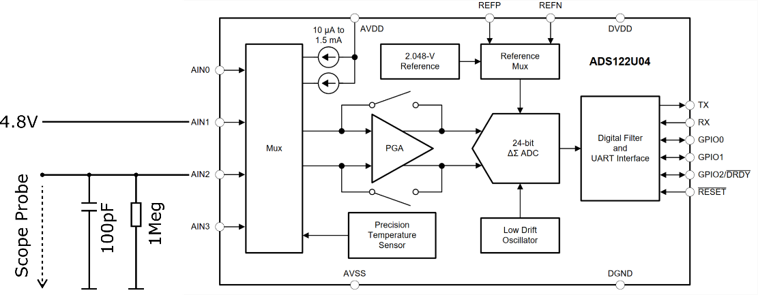Other Parts Discussed in Thread: ADS124S08
Hi TI Team,
I have some questions about the ADS122u04.
I am using this IC in a unipolar configuration. The analog supply voltage is 5.3V (±1%), the digital supply is at 3.3V (±1%). All analog input signals are single ended referenced to AVSS.
The ADC is configured in turbo mode, and single-shot conversion mode. The internal multiplexer manually scans over each channel. After one sample is taken the multiplexer switches to the next channel.
To make use of the whole absolute input voltage range of the analog inputs, I disabled the PGA and use only gains of 1, 2 and 4.
Configuration:
The analog voltage on the inputs ranges from 1mV to 5,002V in my application. I use a RC filter with 1kOhm and 100nF at the input.
According to the datasheet the absolute input current of the analog inputs is ±10nA with disabled PGA in turbo mode. This causes a voltage drop of ±10µV across the filter resistor.
Unfortunately this isn´t the case in my application. I observed a drop voltage across this resistor which is dependent on the voltage level of the pin that was sampled in the previous cycle. At this point I´m inclined to think that there is a substantial amount of charge injection / crosstalk through the multiplexer. I couldn´t find any information on multiplexer timing / charge injection in the datasheet though.
To further verify this thesis I replaced the 1kOhm resistor with a 0 Ohm jumper, and fed the ADC input with an opamp output directly. The ADC now measures the predicted voltage. A low impedance driving source seems to get rid of the problem for the most part.
I´ve set up a circuit to verify the multiplexer function as follows:
I´ve connected a DC voltage source to the AIN1 pin of the device. AIN2 is loaded with a 1Meg resistor to ground, parallel to a 100pF capacitor. I´ve connected a 1:1 scope probe from AIN2 to ground. The probe loads the Input with additional 14pF and 1Meg to ground. Once the multiplexer starts switching the scope shows very large spikes on AIN2. The amplitude of the spikes are dependent on the DC level on pin AIN1.
What causes this problem? What is the recommended workaround except a low impedance driving source? Is this effect dependent on the device temperature as well?
Upon research in this forum I found a post from Ben Benjamin discussing the dynamic range of this ADC.
He says that, quote: “Another consideration is the ADS122U04 is considered a DC type sensor device in that its primary purpose is to measure signals near DC levels.”
I use an auto-calibrate function in my application, which switches between the signal of interest, and a known reference source. This results in a ~105Hz square wave signal on the ADC input. The voltage in this case can swing from 0,614V to 4,8V. Is this still considered DC level? I couldn´t find any information about the analog frontend bandwidth in the datasheet, only information on the digital filter bandwidth. Is the internal frontend circuitry fast enough to give me precise readings in the application described above?
The datasheets states the following about the digital filter:
“The device uses a linear-phase finite impulse response (FIR) digital filter that performs both filtering and decimation of the digital data stream coming from the modulator”
Does the digital filter receive any channel information, or does it filter the products of multiple MUXed channels?
Thank you in advance!
Best regards
Lukas



